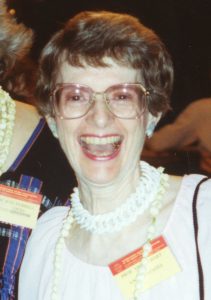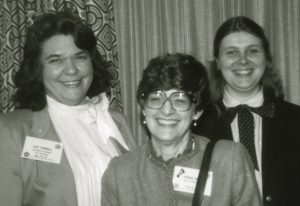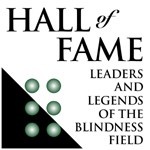Verna Hart
Inducted 2023
By Kay Ferrell
 Verna Hart (1928-2021) received her B.A. in Speech Correction from the University of Michigan in 1950, her M.A. in Deaf Education from Wayne State University in 1964, and her Ed.D. in Multiple Handicaps from Wayne State in 1967. Born, reared, and married in Michigan, Dr. Hart and her husband were parents of a child with complex needs, which not only led her into the field of special education, but created a champion for the cause of all children with multiple disabilities. As she told the Committee on Education and Labor of the United States House of Representatives (1986), she pursued a career in special education not of her own choosing: “I had not planned on teaching following the birth of my children, but my second child was born handicapped, and the expense of maintaining that child not only put me back in the workforce, but led me to take both full and part-time jobs.”
Verna Hart (1928-2021) received her B.A. in Speech Correction from the University of Michigan in 1950, her M.A. in Deaf Education from Wayne State University in 1964, and her Ed.D. in Multiple Handicaps from Wayne State in 1967. Born, reared, and married in Michigan, Dr. Hart and her husband were parents of a child with complex needs, which not only led her into the field of special education, but created a champion for the cause of all children with multiple disabilities. As she told the Committee on Education and Labor of the United States House of Representatives (1986), she pursued a career in special education not of her own choosing: “I had not planned on teaching following the birth of my children, but my second child was born handicapped, and the expense of maintaining that child not only put me back in the workforce, but led me to take both full and part-time jobs.”
Hart was a special education teacher and administrator in Michigan from 1952-1967. She joined the faculty of George Peabody College in Nashville, TN in 1967, where she coordinated programs on multiple handicaps and deafblind education. Hart responded to the rubella epidemic of the mid-1960s and the growing number of infants kept alive by medical intervention by recognizing that the field of visual impairment should expand to serve children with additional disabilities. She created one of the first deafblind teacher preparation programs while at Peabody and worked with legendary colleagues Sam Ashcroft and Randall Harley to advocate for the needs of children with visual impairment who also had additional disabilities. In a radical 1969 article in the New Outlook for the Blind, she challenged the field to accept responsibility for children with multiple disabilities, particularly questioning the idea that “only nice, bright, blind children should be the responsibility of teachers for the blind.” In the same article, she stated that, “The blind child who is functioning on a retarded level is not a blind child plus a retarded child. The two handicaps do not function as addends but as multipliers.” This principle was soon adopted by every teacher education program within and outside of visual impairment.
In 1972, Hart moved to the University of Pittsburgh and coordinated the teacher preparation program in multiple disabilities. She was a tireless advocate. She offered ten essential rights of children with multiple disabilities that could not be ignored. These rights emphasized the broad concepts of advocacy for early intervention; parent education and support; well planned lessons; deliberate changes in materials and experiences to support interest and the generalization of concepts; expectations and support for independence; high expectations; real life behavioral consequences; and well-trained personnel.
 While at Pitt, Hart’s research and teaching evolved toward the emerging field of early intervention for infants and toddlers. From 1982-1985 she assisted the Western Pennsylvania School for Blind Children to implement an intensive interdisciplinary program for infants with visual impairment, which culminated in the first federal grant in train teachers to work with multihandicapped infants in 1986. Her 1984 Journal of Visual Impairment & Blindness article again challenged the field to provide research-based assessment and curricula in early intervention programs for visually impaired infants. Many of her ideas—transdisciplinary approaches, parent education, individualized assessment and programming—were later incorporated into aspects of the Individuals with Disabilities Education Act Amendments of 1986. Notably during this time, Hart contributed multiple chapters in textbooks addressing special education, orientation and mobility, and severe disabilities.
While at Pitt, Hart’s research and teaching evolved toward the emerging field of early intervention for infants and toddlers. From 1982-1985 she assisted the Western Pennsylvania School for Blind Children to implement an intensive interdisciplinary program for infants with visual impairment, which culminated in the first federal grant in train teachers to work with multihandicapped infants in 1986. Her 1984 Journal of Visual Impairment & Blindness article again challenged the field to provide research-based assessment and curricula in early intervention programs for visually impaired infants. Many of her ideas—transdisciplinary approaches, parent education, individualized assessment and programming—were later incorporated into aspects of the Individuals with Disabilities Education Act Amendments of 1986. Notably during this time, Hart contributed multiple chapters in textbooks addressing special education, orientation and mobility, and severe disabilities.
Hart was an active participant in professional organizations, holding officer positions in deafblind associations, the Association for Education of the Visually Handicapped (AEVH) and its successor the Association for Education and Rehabilitation of the Blind and Visually Impaired (AER), as well as being a founder of the American Association for Education of the Severely Handicapped (which later became TASH). She was chair of Division VIII (Infant and Preschool) of AER and an active contributor to the International Preschool Seminar on Visual Impairment.
Hart was the recipient of the Josephine L. Taylor and Berthold Lowenfeld Awards from AER, and the Award for Excellence in Teacher Education from the Council for Exceptional Children (CEC). In the latter phase of her career, Dr. Hart served as a project officer with the United States Department of Education, Office of Special Education Programs, Division of Personnel Preparation.
Verna Hart’s impact on thousands of students, teachers, and families was profound. She changed the way we prepare teachers, and she emphasized the importance of working humbly and respectfully with families as early as possible in a child’s life. She was a model educator, with a firm foundation in research and practice, an ability to transmit knowledge, a commitment to service, and the courage to challenge the status quo.
_______________________
Hart, V. (1986). The Education of the Handicapped Amendments of 1986. Hearings before the Subcommittee on Select Education of the Committee on Education and Labor, 99th Cong. (1986) (pp.144-154). ERIC. https://files.eric.ed.gov/fulltext/ED280251.pdf
Hart, V. (1984). Research as a basis for assessment and curriculum development for visually impaired infants. Journal of Visual Impairment & Blindness, 78, 314–318. doi.org/10.1177/0145482X8407800705
Hart V. (1969). The blind child who functions on a retarded level: The challenge for teacher preparation. New Outlook for the Blind, 63, 318-321. doi:10.1177/0145482X6906301007
